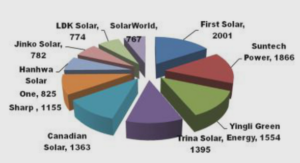Télécharger MÉMOIRE ONLINE synthesis and characterisation of nanostructured magnetic FePt-based alloys, Rapport & document en PDF.
Chapter 1: State of the art
The modern society is today strongly dependent on automation and miniaturization in many aspects. Magnetic materials are widely used in almost any important technical fields. Technological applications such as: electrical and mechanical power, transformers, electromotors, computer and IT industry, telecommunication, navigation, aviation and space operations, automation, micro-electro-mechanics, magnetocaloric refrigeration, materials testing and household applications, have created increasing demands for new and improved magnets [1]. With the advent of the new synthesis procedures that allow preparation of magnetic materials with nanometric structural characteristics, such as nanoparticles, thin films, multilayers, etc. the area of possible applications for nanometric-sized magnetic materials has considerably broadened. Nowadays, such nanoscopic magnetic materials are used in magnetic recording [2-4], as magnetic sensors, in magnetoelectronics [5-7] or in a wide range of biomedical applications [8,9].
From the point of view of their properties of interest for various applications, magnetic materials may be classified as soft magnets and hard magnets. Most of the important properties of any magnetic material are described by its magnetization, or hysteresis curve, which plots the magnetic flux, B, induced in the material (measured in units of gauss or tesla) against applied magnetic field, H (measured in units of oersted or A/m). The nature of this curve determines whether a material is considered as ‘soft’ or ‘hard’.
An ideal soft magnetic material is one whose magnetic flux increases constantly with magnetic field and shows no hysteresis. Soft magnetic materials make good transformer cores because they can be easily magnetized, reproduce exactly the changes in applied magnetic field, and minimize losses due to hysteresis. However, they make poor permanent magnets because they do not remain magnetized once the applied field is removed.
In contrast, an ideal hard magnetic material is one whose magnetization curve is strongly nonlinear, and which follows a broad hysteresis loop. If gradually removing the applied magnetic field, the magnetization has large non-zero values at zero applied field (remanent magnetization) and needs applying field with an opposite sign to bring the magnetization back to zero (coercive field). Hard magnetic materials are potentially good permanent magnets because they retain a large degree of magnetization, known as the remanent magnetization, and exhibit high magnetostatic energy required for applications.
………..
Synthesis and characterisation of nanostructured magnetic FePt-based alloys (3.02 MB) (Rapport PDF)





